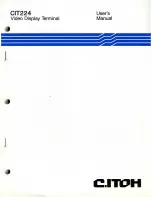
CommandPro
®
General Purpose & Safety Applications
User Manual
8
9M02-9028-A031-EN
Rev 4
4.
Introduction
Cattron CommandPro
®
Wireless Control Systems are designed for control of industrial machinery. The rugged
controls are built to survive the wear and tear of life in factories, mills, and foundries. These systems comply with
requirements for operation under Part 15 of the FCC Rules and Regulations. This means neither the operator nor
the company need apply or register for a license to operate this equipment.
The Cattron Safety Stop Remote Control System is designed to provide the means for an operator to remotely
stop electrical equipment in times of emergency. The Safety Stop Remote Control System is used as a
supplement to the hard wired Emergency Stop switch on equipment and not as a replacement for such function.
The basic system consists of a transmitter and a receiver. The transmitter sends commands to the receiver by
means of radio waves in the 900 MHz band. Receivers operate at 115 VAC 50/60 Hz power. Operations from 220
VAC, 24 VAC, 12 VDC, or 24 VDC are also available. The receivers feature easy ‘screwdriver’ maintenance,
making troubleshooting and repairs simple. The Cattron CommandPro
®
Wireless Control Systems are UL-508
approved in the United States and CSA-C22.2 approved in Canada.
4.1
How the System Works
4.1.1 Frequency
Cattron equipment operates in the range from 902 to 928 Megahertz (MHz) band. A wavelength at our frequency
is 12.9 inches.
Like light, 900 MHz radio signals pass through glass and plastics, and will reflect off of walls, buildings, and metal
structures. Unlike light, 900 MHz radio signals penetrate all plastics, including those that you cannot see through,
as well as thin-gauge steel, dry wood, dry concrete, plasterboard, fog and rain.
However, trees, earth, water, people, aluminum, copper and some window tints will not readily pass our signals.
4.1.2 Range and Antenna Coverage
Antennas convert radio signals into radio waves and convert radio waves back into radio signals. They can send
and receive in all directions or in a single direction, depending on their design.
An omnidirectional antenna is like a light bulb, and a directional antenna is like a flashlight. Metal objects reflect
radio waves, just as a mirror next to a light bulb will reflect light. Metal objects near an antenna alter the intended
pattern of an antenna by either shading or reflecting signals.
Our standard antennas are omnidirectional; they ‘see’ equally well in all directions. We have other antennas that
will ‘see’ further in one direction for special applications.
4.1.3 License-Free Channels
The 902 to 928 MHz spectrum is set aside by the FCC as an ISM Band (Industrial, Scientific and Medical), and
this spectrum accommodates many license-free users. We have the ability to change frequencies in this band,
and we have 81 different channels that we can assign to our transmitters and receivers. The actual frequency is
coded into the receiver and transmitter at the factory, but it can be changed to one of the other 80 channels in the
field.
Other devices in this band include wireless phones, computer data links and inventory equipment. As a condition
of using this band, our products must accept and handle interference from other users.









































